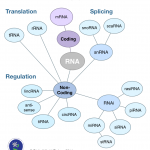microRNA
Since mental health problems are estimated to affect some 10% of the world’s population, it stands to reason that if you don’t suffer from depression, anxiety or bipolar disorder yourself, you are probably close to someone who does. So you might be pleased to read about a new finding that could eventually lead to a whole new approach to treating this group of common mood disorders.
The finding is that a tiny scrap of RNA – a microRNA that works in the brain – acts as a sort of mood regulator. It works something like the needle in a steam valve. Mice that had high levels of this particular…
By @finchtalk (Todd Smith)
In 2014 and beyond Finchtalk will be contributing to Digitalbio’s blog at this site. We kick off 2014 with Finchtalk’s traditional post on the annual database issue from Nucleic Acids Research (NAR).
Biological data and databases are ever expanding. This year was no exception as the number of databases tracked by NAR grew from 1512 to 1552. In the leadoff introduction [1] the authors summarize this year’s issue and the status of the NAR index. The 21st issue includes 185 articles with 58 new databases and 123 updates. In the 1552 database repository, 193 had their…
Heidi Stevenson amuses me. I know, I know, I've started a previous post with exactly this sentence a mere month ago, but it's so damned appropriate that I can't help but try it again.
A homeopath (which means that she's reality-challenged to begin with), she's produced some of the most hilariously off-base, pseudoscientific, and downright antiscientific articles I've ever seen. Examples include the times when she launched a truly nonsensical attack on Stephen Barrett of Quackwatch, lectured scientists about anecdotal evidence, or, most hilariously of all, utterly misunderstood the concept of…
Blurring, chopping and blocking. Three online items this week all deal with some pretty dynamic phenomena.
The blurring is in our perceptions. It turns out that if you even think you have lost money in an experiment, your ability to distinguish between musical notes will be hampered. What’s the connection? Dr. Rony Paz has been showing that this tendency to lump sounds together is tied to fear. In our evolutionary past, humans may have survived because anything that sounded remotely like a predator aroused an immediate “fight or flight” response. But if mild stress can provoke a similar…
It is now well established that the adult mammalian brain contains stem cells which continue to generate new neurons throughout life. This discovery, and subsequent research, has transformed the way we think about the brain. It is, for example, known that physical and mental exercise can stimulate the growth of new nerve cells in a part of the brain which shrinks in Alzheimer's and depression, and so it is believed that such activities can reduce the risk of both conditions.
Despite all this, little is known about the mechanisms by which neural stem cells are directed to generate neurons.…

